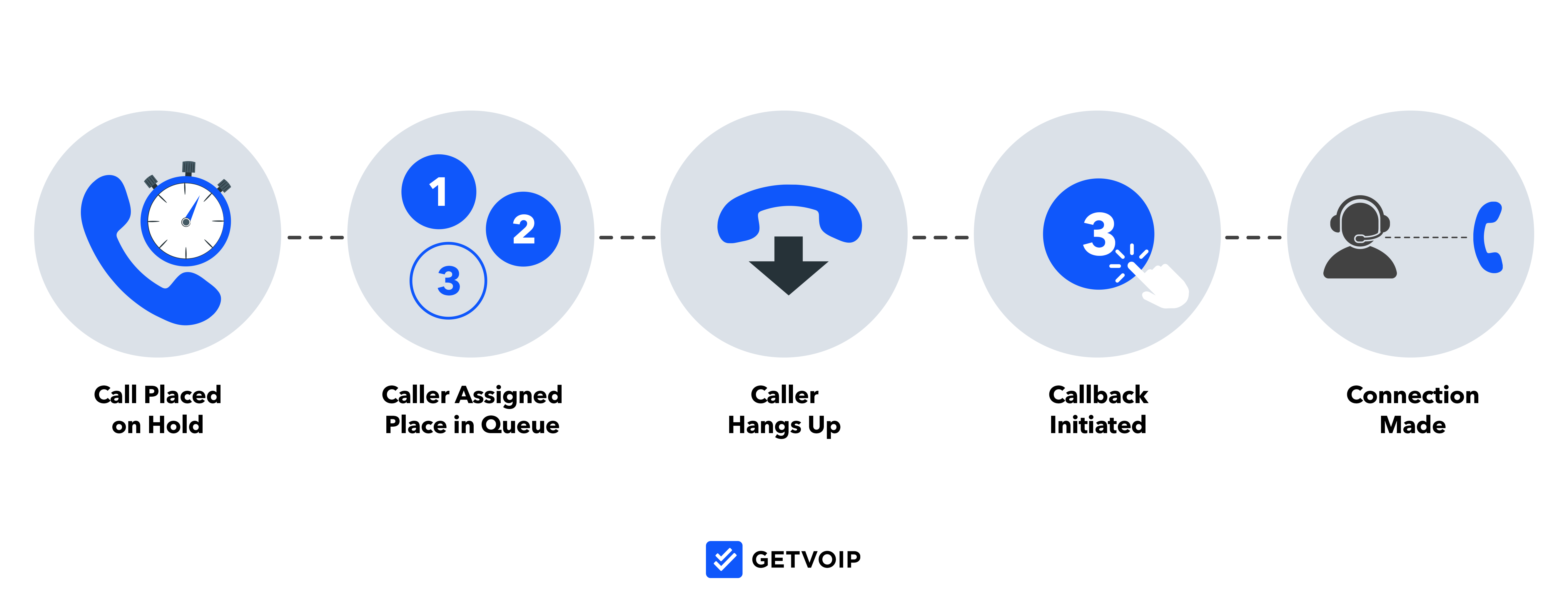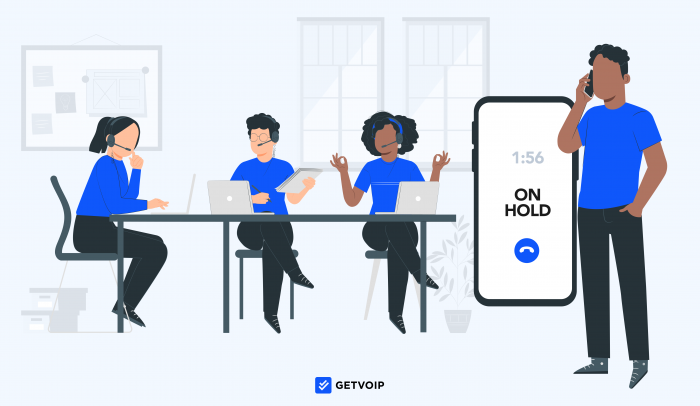While internal business miscommunication is costly, it often pales in comparison to the costs of lost revenue and time from long customer hold times.
But what can you do to reduce hold time for your callers without having to shoulder the extra expense of hiring additional contact center agents?
With the right software and features, you can increase agent efficiency and ensure that your customers connect with agents faster and receive better quality support.
Read on for actionable tips about how to shorten customer wait time and improve your call center experience for both clients and agents.
Why Hold Times Matter
It's no secret that being put on hold is annoying, makes clients feel like a low priority, and can cause customers to lash out at your agents.
What most companies aren’t aware of?
Just how much of a negative impact lengthy hold times have.
Statistics show that:
- Over 70% of business calls result in a hold time of at least 45 seconds. (Source)
- The average hold time is approximately 13 minutes for callers to a contact center (Source)
- Nearly 60% of consumers say that long hold times are one of the most frustrating parts of the customer experience (Source)
- 60% of customers who have waited on hold for too long will just hang up (Source)
- ⅔ of consumers say they would only wait for up to two minutes on hold (Source)
8 Ways to Reduce Нour Hold Time
There are several things you can do to both ensure customers spend a minimum amount of time on hold and collect as much information from them as possible to ensure that, when they do connect with an agent, the call goes as smoothly and efficiently as possible.
To reduce hold times, you should:
- Monitor Agent Performance
- Offer Customer Callbacks
- Improve Self-Service With IVR
- Provide An Omnichannel Communication Experience
- Use Call Routing
- Update Hold Music and Messages
- Integrate Your CRM Software
- Update Your Knowledge Base And Call Scripts
Monitor Agent Performance
The first step in shortening hold time is to get a better understanding of how your call center agents are spending their working hours through historical and real-time analytics.

Essential metrics and KPIs to monitor include:
- First Contact Resolution Rates: How often customer service issues are resolved on the first phone call
- First Response Time: How long it takes available agents to answer a phone call
- Average Hold Time: How long customers wait on hold before reaching an agent
- Call Abandonment Rate: How often calls hang up before reaching an agent/voice mailbox
- Number of Active Waiting Calls: The number of people currently on hold when compared with the current call volume
- Call Arrival Rate: The number of inbound calls a contact center receives within a set time-frame
- Average Call Length: Total Call Time for All Calls ➗ Total Number of Calls
In addition to the above data, make sure to monitor agent productivity.
Key metrics for evaluating agent performance include the average speed of answer, the average number of calls per hour, the average transfer rate, and each agent’s average call handling time.
Knowing these analytics will help you understand your average daily call volume, determine peak call times, and decide if you need to hire more agents or just tweak current agent schedules.
Most importantly, you’ll get a clear understanding of what’s working at your call center, and what may be contributing to longer hold times.
Offer Customer Callbacks
Your customers aren’t willing to wait on hold, but you don’t want that to mean you never hear from them again. Plus, just because a customer doesn’t want to spend a long time waiting on hold doesn’t mean their questions or inquiries magically vanish.

So, what’s the solution?
For many, it's customer callbacks.
In short, this allows callers to get an estimated wait time and choose whether they’d like to continue to remain on hold, or if they’d rather receive a callback at a pre-scheduled time (they can also get a callback from the next available agent.)
Even better?
Clients won’t lose their place in the call queue just because they’ve opted for a callback.
Improve Self-Service With IVR
One way to give your customers more control while also freeing up your agents to attend to more time-sensitive and pressing issues?
Implement Interactive Voice Response (IVR) on your phone system.

IVR allows for a high level of customer self-service by using pre-recorded prompts and messages that guide callers through a set path of actions. If you’ve ever “pressed 1 to be connected to the billing department,” then you’ve interacted with an IVR system.
Not only does IVR make sure that your callers are connected to the right agents and departments, but it also lets them pay their own bills by entering numbers in their keypad, access specific prerecorded guides, or skip automatically to a voice mailbox.
Provide An Omnichannel Communication Experience
One way to guarantee shorter hold times?
Give your customers access to additional communication channels.

After all, the more ways your customers have to talk to your agents, the lower the likelihood that any one of these channels will get overwhelmed. Plus, you’ll have the added benefit of reaching out to your customers in the way they prefer -- meaning a much higher engagement rate.
Business text messaging, website chat messaging, and even video calls or social media chat messaging are additional ways today’s consumers want to connect with support and sales departments.
Most contact center systems will save customer preferences for communication channels, so in the future, you can connect with them in the best way from the very first interaction.
Use Call Routing
We’ve all experienced the annoyance of waiting for what feels like an eternity on hold, only to be connected to an agent that can’t even help you.
This means more callbacks, a lower first call resolution rate, and frustration all around.

Implement call routing and skill-based routing to make sure the callers connect with the agent who is the most qualified to help them on the first try. Calls will follow predetermined paths based on information that the customer inputs into the IVR system through the keypad or natural language processing.
Choose from several options including skills-based, most idle, round-robin, or list routing to keep agents from getting overworked or underused.
Update Hold Music And Messages
You might not think that hold music makes much of a difference to customers -- but consider how irritating it is to hear endless phone rings while you’re waiting to be connected to an agent.
The right music can keep customers calm and provide entertainment for a few minutes, but if they’re waiting for longer than that, you need to do more than rely on Mozart alone.
Even if you do offer a callback option, some customers will always choose to remain on hold.
Take advantage of the time you have with these clients -- especially since you’re paying for every minute they spend on hold -- and keep them updated on their queue placement with the right messages.
Take advantage of message automation. Have a message play after a set amount of time that provides hold time estimates and tells callers their current place in the line. Additionally, play a series of messages updating customers on new products/services, company news, or even offering discount codes.
It’s not just about keeping customers entertained, either.
In fact, a study from US West Communications found that playing messages that provide valuable information and updates to callers result in a 40% increase in caller hold retention, and an over 10% increase in customer inquiries.
Even small changes like hold music and automated messages can have a big impact.
Integrate Your CRM Software
We all know the frustrating feeling of having to explain the same reason why you’re calling or once again providing your contact or order numbers every time you connect with a new representative.
One way to avoid this -- and to make your business phone calls more productive and shorter in the process -- is to integrate your current CRM software with your current call center platform.

Not only does this provide essential customer data like contact information, but CRM integrations also let agents review past client interactions/calls, see active order information, and read notes left from other agents.
CTI screen pops that display all this information and more will automatically pop up when a customer makes an inbound call, or right before an agent makes an outbound one.
This makes it easy for agents to be prepared for calls, understand how to best help the client, and as a result, solve the issue much faster than usual (many times, within a single call.)
Not only does this save time, but it also improves the overall customer experience.
Update Your Knowledge Base and Call Scripts
Just as you update your employee training materials, you also need to frequently update your internal knowledge base and call scripts.
A knowledge base contains a searchable private internal company, product, and customer information to make it easier for agents to find the information they need to assist a customer as quickly as possible.
Additionally, these wikis provide step-by-step directions and “how-to” guides that agents can access while on the phone with a customer to walk them through exactly how to solve the issue or let agents know what advice to give.
This cuts down on the number of callbacks and call transfers to other agents.
Instead of waiting for a specific agent or higher-up to become available and answer questions, customer service reps can use the wiki to tell the customer exactly what to do.
This means agents from other departments may also be able to assist customers who need phone support, even if they’re not in the billing department or a product representative, by just reading the customer the information in the knowledge base.
Make sure to keep these bases updated frequently, especially when you make major changes to your business software, agent schedules, or order process.
The same thing goes for any call scripts, whether they’re for customer support or outbound sales calls.
Make sure they contain the most relevant, up-to-date information, and test out several different script versions to see which one is the most effective.
The Right Call Center Software Shortens Wait Times
In order to properly and effectively implement the changes we’ve mentioned here and reduce your call hold times, you’ll need the right software.
An omnichannel contact center offers all of the features we’ve covered in this post, plus many more.
Top features to look for in a CCaaS provider include:
- Multiple dialing modes
- Call monitoring and coaching tools
- Call recording
- Voicemail transcription
- Click-to-call
- Conference calling
- Call queuing, call forwarding, call paths
To learn more about how features like those listed above will improve internal and external communication and customer satisfaction, use our interactive comparison table to compare call center software providers and rates. Increase team productivity, decrease miscommunications, and offer your clients better ways to connect with you using the right tools.
FAQs About Customer Hold Time
Below, we’ve compiled a list of some of the most common questions about hold time and its effect on the customer and user experience.



